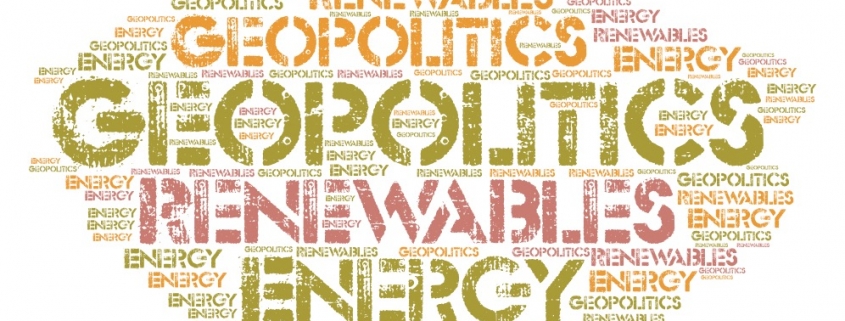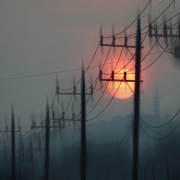Reality or just a myth
Are we entering an era where renewables and low carbon technologies are going to replace fossil fuel and the associated geopolitical complexities? Early this year, the executive director of the International Energy Agency, Dr Fatih Birol highlighted the rapid penetration of clean energy technologies into the future energy mix – especially in China, the largest energy consumer and carbon emitter. Inevitably, the energy status is changing, but little is known about the impact on the global energy economy.
Over the last century, the world has experienced a heavy reliance on OPEC oil reserves. In many cases, a search for energy resources has caused geopolitical tensions. The global oil crisis in 1973 has taught the world how oil cuts can disrupt global industrial production. Two more recent examples; in 2008, China’s decision to patrol the maritime trade routes stirred further tension in the South China Sea; also, the 2009 Russian gas cutoffs in Ukraine put EU energy supplies at risk. Both examples reveal how the fossil fuel era has stimulated global economic growth but also caused regional conflicts.
The dynamic penetration of green technologies in the energy mix is expected to limit the reliance on oil imports; every state will be able to use its own renewable resources to meet domestic needs. However, the replacement of fossil fuel is far from reality. The 2017 World Energy Outlook forecasts that oil demand will continue to grow by 2040 – yet to a slowly decreasing rate (IEA, 2017). In addition, low carbon projects remain an expensive solution for many countries – due to lack of capital and further political reforms. Until then, fossil fuel will continue to play an important role in the energy mix – especially after the recent shift in the US energy policy and Trump’s reservations towards climate change policies.
Assuming that these burdens are lifted, the switch to a green economy will still carry geopolitical dimensions. According to a peer review, “historically every big shift in the global energy mix has brought with it its geopolitical ramifications; renewables will be no exception” (M.L O’ Sullivan, 2017). Early this year, the World Economic Forum in Davos alerted the global policymakers and businesses over the geopolitical deterioration as a top risk for the global economy. Among the new energy players, renewable generators will not only seek to export their energy surplus but also gain geopolitical advantage. The existing tension between the US and Chinese trade relations may trigger a new ‘arms race’. Following the shift in China’s energy policy, plans for expanding its domestic production in high-efficient and clean technologies is likely to attract foreign capital – leaving behind the European and US research development.
Also, countries rich in rare earth mineral reserves will play an important role in the new energy system. Materials like lithium, cobalt, and indium are massively used for the construction of renewable projects. This reliance may create a new disproportion between mineral importers – exporters. For instance, cobalt is widely used for the production of solar panels and batteries reserves. Since half of the global reserves are located in the Democratic Republic of the Congo, the country can turn into a new powerful energy player. In reality, the mining of these minerals remains the privilege of a small group. The extraction of these materials is an expensive and non-profitable option for many countries, which narrows down the list of future energy players. Today, China produces approximately half of the world’s rare earth elements (US Geological Survey, 2016). In the past, China has used its production capacity as leverage towards Japan¹.
Finally, the cross-border trade of electricity – via smart grids – is anticipated to ease the distribution of renewable energy among neighbouring countries. On the other hand, this type of interconnection will be prone to new vulnerabilities such as regional instabilities and cyber-attacks – to the same way that gas pipelines have threatened the EU energy security due to political instabilities in Eastern Europe.
All in all, a new era of energy geopolitics emerges with positive and negative aspects for the global energy market. The new energy system will be more stable but also more complex than the oil-based system. On the bright side, the diversification of renewable resources will lead to a more decentralized energy system with a focus on the local energy demand. On the downside, a number of complexities will define the integration rate of renewables into the local energy mix. Sooner or later, traditional energy suppliers – OPEC and Russia – will see their geopolitical power diminishing by new renewable players – China, Germany, USA, Japan (Paltsev, 2016). As long as states strive for a secure energy future, conflicts between global energy players will continue – to a greater or lesser extent – in the low-carbon economies.
Footnotes
[1] China has used its production capacity as leverage towards Japan:
Following the detention of a Chinese fishing trawler captain from the Japanese authorities, China decided to ban its mineral exports, causing serious disruptions in the Japanese industry specialized in the production of renewable technology, hybrid cars and missiles (Bradsher, 2010).
Bibliography:
Birol F. (2016) Global Energy Markets in Transition: Implications for the economy, environment & geopolitics, Analysis Meeting on International Finance and Economy, OECD/IEA, 21st April, Available at: https://www.iea.org/media/speeches/birol/1604213_Birol_Tokyo_slides.pdf (Accessed 22nd March 2018)
Bradsher K. (2010) Amid Tension, China Blocks Vital Exports to Japan, The New York Times, 22nd September, Available at: http://www.nytimes.com/2010/09/23/business/global/23rare.html (Accessed 23rd March 2018)
Dudley D. (2018) Renewable Industry Starts to Grapple With The Geopolitical Impact Of Shift To Green Energy, Forbes, 14th January, Available at: https://www.forbes.com/sites/dominicdudley/2018/01/14/renewable-energy-geopolitical-impact/#67ebeeb2f49b (Accessed 23rd March 2018)
IEA (2017) World Energy Outlook 2017 Executive Summary, OECD/IEA, Available at: https://www.iea.org/Textbase/npsum/weo2017SUM.pdf (Accessed 22nd March 2018)
IEA (2018) IEA presents global energy market outlook before the United States Senate, Newsroom, 16th January, Available at: http://www.iea.org/newsroom/news/2018/january/iea-presents-global-energy-market-outlook-before-united-states-senate-.html (Accessed 22nd March 2018)
O’Sullivan L. M. (2017) Renewables won’t end geopolitics of energy, The Japan Times | Bloomberg, 24th August, Available at: https://www.japantimes.co.jp/opinion/2017/08/24/commentary/world-commentary/renewables-wont-end-geopolitics-energy/#.WrDwo2acbVr (Accessed 20th March 2018)
O’ Sullivan L.M., Overland I. and Sandalow D. (2017) The Geopolitics of Renewable Energy, Columbia University | SIPA: New York, Harvard Kennedy School: Cambridge MA, Available at: http://energypolicy.columbia.edu/sites/default/files/CGEPTheGeopoliticsOfRenewables.pdf (Accessed 21st March 2018)
Sergey Paltsev (2016) The complicated geopolitics of renewable energy, Bulletin of the Atomic Scientists, 72(6): 390-395, Available at: https://www.tandfonline.com/doi/pdf/10.1080/00963402.2016.1240476?needAccess=true& (Accessed 21st March 2018)
Stratfor (2018) At Davos, Geopolitics and Business Dance a Winding Waltz, Reflections, 23rd January, Available at: https://worldview.stratfor.com/article/davos-geopolitics-and-business-dance-winding-waltz (Accessed 23rd March 2018)
Tagotra N. (2018) Asia’s Energy Security Future: The Geopolitical Dimension, The Diplomat, 1st February, Available at: https://thediplomat.com/2018/02/asias-energy-security-future-the-geopolitical-dimension/ (Accessed 23rd March 2018)
U.S. Geopogical Survey (2016) Mineral Commodity Summaries, Available at: https://minerals.usgs.gov/minerals/pubs/commodity/rare_earths/mcs-2016-raree.pdf (Accessed 22nd March 2018)







Leave a Reply
Want to join the discussion?Feel free to contribute!